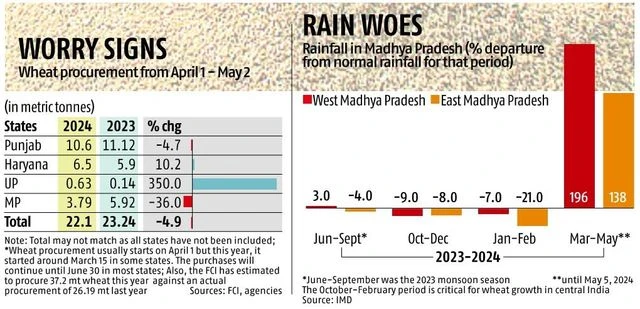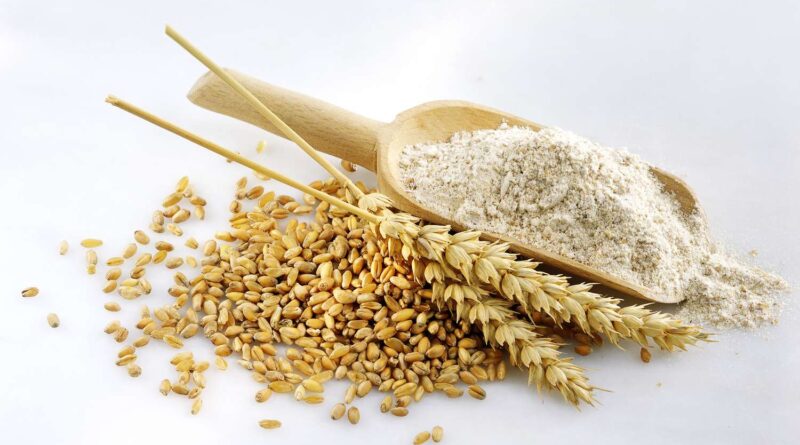Madhya Pradesh farmers struggle to make the most of soaring wheat prices
By Reuters
Dwarka Prasad Meena, a farmer at Bhainswa village in Madhya Pradesh’s Rajgarh district, is grappling with water scarcity that has severely impacted his wheat harvest. Despite his best efforts, yields have plummeted by at least 20 per cent on his farm.
Meena, who cultivates wheat on approximately 20 acres, says that inadequate rainfall and poor irrigation systems have also affected his coriander crop. As the state prepares for the third phase of polling on Monday, the issue of dwindling wheat production has become a hot topic among farmers.
Madhya Pradesh had set a target to procure around 8 million tonnes (mt) of wheat from farmers for the central grain pool this year (2024-25). However, as of May 2, only about 3.7 mt have been procured, marking a 37.2 per cent decrease compared to the same period last year.
In the 2023-24 marketing year (April to March), the state procured around 7.09 mt of wheat throughout the season. Across the country, wheat procurement until May 2 stood at 22.10 mt, a decrease of around 4.9 per cent compared to the same period last year, with Madhya Pradesh leading the decline.
This dip in procurement has occurred despite the state government announcing a bonus of Rs 125 per quintal over and above the Centre-fixed minimum support price (MSP) of Rs 2,275 per quintal for the 2024-25 purchase season. This means that wheat from Madhya Pradesh farmers is being procured at a price of Rs 2,400 per quintal, while the MSP is Rs 2,275 per quintal.
Nityanand Roy, team leader of the grains desk at agritech startup Agriwatch, says here are several reasons for the drop in procurement. “Farmers are holding on to their produce in anticipation of an even better price sometime in the next few months. I estimate that almost 30-35 per cent of farmers in MP are still holding on to their wheat,” he says.
)
The price of the ‘Lokwan’ wheat variety in
Madhya Pradesh’s Indore mandi is quoted at Rs 2,900-3,150 a quintal, while the ‘Poorna’ variety is quoted at around Rs 2,650-3,000 per quintal. These rates are significantly higher than even the bonus-induced MSP of wheat in MP, which is Rs 2,400 per quintal.
Wheat production is down by 2-3 per cent, says Roy, but in some areas, the quality of the crop has deteriorated due to untimely rains, which is why the Food Corporation of India (FCI) had to relax its quality parameters for the state.
A survey by Agriwatch — for the Roller Flour Millers Association of India done a few months back — had pegged Madhya Pradesh’s wheat production in 2024-25 at 24.99 mt, which was marginally up versus 24.54 mt of the previous year, pegged by the same group.
The purchase price, though higher than MSP, has itself become a talking point as the ruling BJP in the Assembly elections held in December 2023 had promised to purchase wheat at a price of Rs 2,700 per quintal (which would have meant a bonus of Rs 425 per quintal for the current MSP).
Digvijay Singh, former Madhya Pradesh chief minister and the Congress’ Lok Sabha candidate from Rajgarh, criticised the BJP’s procurement price during a recent public function on his campaign trail. “The BJP had promised to purchase wheat from farmers at a price of Rs 2,700 per quintal in the run-up to last Assembly elections, but are now paying just Rs 2,400 a quintal which is nothing but deception.”
Most analysts predict that in Madhya Pradesh, government wheat procurement this year will remain significantly lower than last year despite an extension of the purchase deadline until May 20 from the earlier closing date of May 5.
However, for Suresh Babu Meena, another farmer from Bhainswa village in Rajgarh, the falling yields, which have halved this year in several farms due to a prolonged dry spell, are a greater concern than the price. “Our wells dried up and we could not water the wheat crop properly even through pumps as there was simply no water anywhere,” Meena explains.
Data sourced from the India Meteorological Department (IMD) showed that rainfall has been scarce in the state since the 2023 monsoon season. In the October to December months, rainfall in western Madhya Pradesh was 9 per cent below normal, while in the eastern parts of the state it was 8 per cent below normal. This worsened even further in the subsequent January to February months, with rainfall in western MP 7 per cent less and in eastern parts of the state 21 per cent below normal. The October-February period is critical for wheat growth in central India.
Rahul Chauhan, a commodity analyst at iGrain India, explains: “The procurement has sharply dipped in MP as first, the crop was late, second, market rate is ruling much higher than even the MSP-plus bonus price, and finally, both farmers and traders are holding on to the wheat crop in anticipation of further rise in prices.”
With Madhya Pradesh emerging as a significant state in terms of annual wheat procurement for the central pool in recent years, a below-par performance is bound to have national ramifications.
This article has been republished from The Business Standard.

